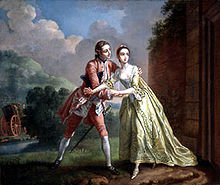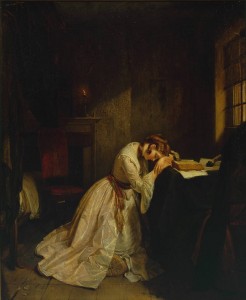Letter 36 in Volume I contains Clarissa’s story of meeting Lovelace in the garden. Tony pointed to “one of the real satisfactions of encountering this letter—the chance to see Clarissa and Lovelace face-to-face, and to see them ‘trade’ language so vividly. She asserts herself against Lovelace as strongly as against her family, but with more of a belief that she has a receptive audience here—even to her criticisms. And of course, so early in the novel, we can still have some hopeful expectations about Lovelace, despite his reputation.”
Responding also to Letter 36, Jessica, however, became nervous, particularly about how Lovelace frames Clarissa’s options and how “masterful he is at rhetorically framing himself as a hurt party whose pain could be alleviated if only the object of his desire would just go along with what he wants. And Clarissa is so good at seeing and articulating the underlying bias of Lovelace’s construction of reality, even though she’s persuaded on some level that he is ‘suffering.’” Rachel agreed that “Clarissa has a weakness for Lovelace—is it her Puritan optimism that there is redemption for every rake? I’m not sure. Because I also think that Clarissa likes Lovelace with her mind and reasoning just as much as her soul and hope for redemption.”
Keri agreed, though pointed to the way “Clarissa is aware of her vulnerability to him. She tries to maintain an agency and approach Lovelace with authority, but she also shows concern that she has let her correspondence with him go on for too long.. . . All that to say, I think I am as confused as Clarissa is. I still can’t quite get a handle on her agency here. She seems very aware of Lovelace’s powerful mind and appreciates his ability to reason, and she also stands up to him at times letting him know that she wishes to marry no one. But she also submits to him because she feels a bit threatened and also sympathetic to him due to the hardships he has endured in trying to maintain correspondence with her.” Kendra too noted Clarissa’s ambivalence: “If she knows his postulations of devotion and love are suspect why does she let herself be drawn to him? . . . What is curious is that Clarissa is suspicious of him but, despite herself and her attraction to his mind, asks Anna ‘do you really think Mr. Lovelace can have a very bad heart?’”
Letter 37 continued to raise questions about Clarissa’s self-knowledge. Steve began by asking “I read this after the scene in the woodhouse thinking ‘is everybody crazy to trust Clarissa’s judgment?’” To which Rachel responded “I asked the same question, also wondering, though, how much Anna actually does trust it. Is their call for detail—always tell me everything, leave nothing out—really just a cry for empirical evidence so they can make their own judgments?” Jessica wondered the same: “Anna writes, ‘Let me add, that if you would clearly and explicitly tell me, how far Lovelace has, or has not, a hold in your affections, I could better advise you what to do, than at present I can.’ I don’t understand this. Clarissa has been so clear. Perhaps we’re supposed to be baffled that no matter how strongly Clarissa insists, she can’t persuade her family and friends that she isn’t in love with Lovelace—another way that Clarissa’s agency is gradually stifled. But the fact that Clarissa’s closest friend has doubts about Clarissa’s feelings for Lovelace makes me wonder what can’t be known through letters alone. We’ve watched how Clarissa’s discourse has its limits (her parents refuse to read her letters; and no matter how clear she is about her dislike for Lovelace, everybody thinks she’s deploying fancy rhetoric to distract from her true feelings). Is there a context we’re missing that is understood outside these letters? Or are Clarissa’s family and friends really this profoundly wrong?” To which Megan responded “The deep intimacy between the two friends has already been established. I wonder if Anna has a better understanding of Clarissa’s feelings and what she could be hiding in her letters. Despite the instructions to leave nothing out, these letters are a construction. Clarissa is purposely giving specific details at certain times. And perhaps some of her words let slip certain ideas that those who do not know her as well would not understand. Surely, her feelings for Lovelace are at least a bit more complicated than we can gather from her letters? Think about this statement from Letter 36—‘I fancy, my dear, however, that there would hardly be a guilty person in the world, were each suspected or accused person to tell his or her own story, and be allowed any degree of credit.’” This sense of the rhetorical constructed-ness of both writing and reading a letter is becoming a major theme for us.
In Letter 42, we also began to see more examples of Clarissa as an agentive self. Kendra saw Clarissa as a “growing character here, because for the first time she seems to delight somewhat in being vindictive and fighting back,’ whereas before she lamented and threw herself upon the floor.” And Meghan concluded by saying that “’Meow!’ is right, Steve. I love finally being able to see Clarissa get angry with someone! Previous to this, I’m reminded of Letter 29 when Clarissa tries writing to her sister from the confines of her room, since she has been ordered to stay there by her family. . . . imploring Arabella to ‘pity’ her. . . . Now, not only does Clarissa abandon the tactic she used before to appeal to Arabella’s love for her as a sister, she deliberately attacks Arabella using something that seems to cause her great pain (her unrequited love for Lovelace). Clarissa seems to have some remorse in retrospect (when she repeatedly asks Miss Howe whether she was justified in her actions and when she refers to Arabella as her “poor sister”), but the fact that she did something like this at all (for me) signals a turning point for her character in finally gaining some nerve instead of only feeling sorry for herself.”

